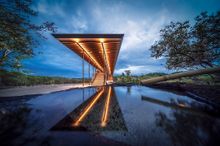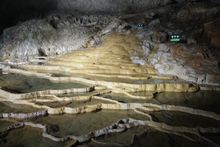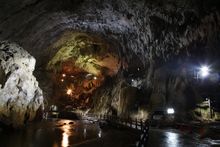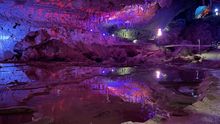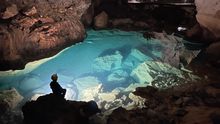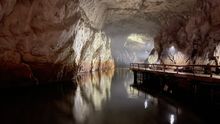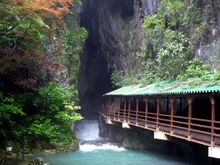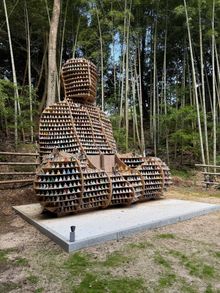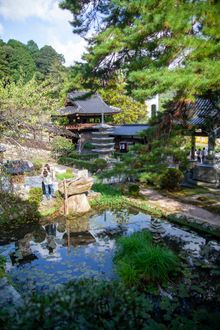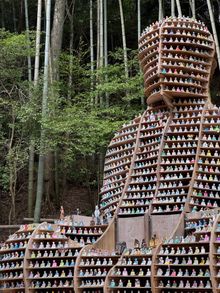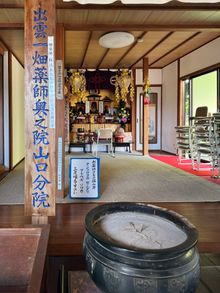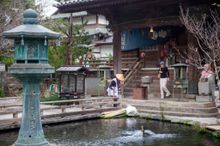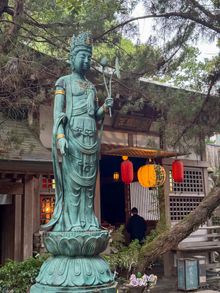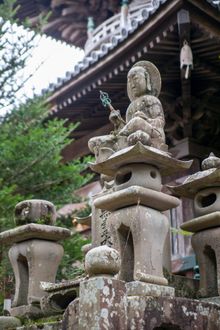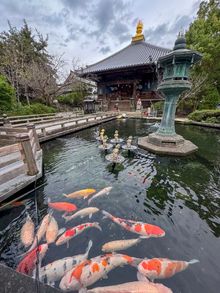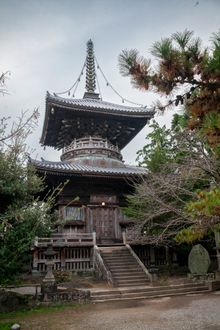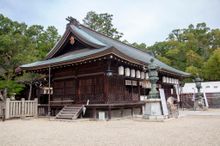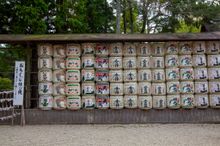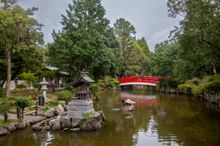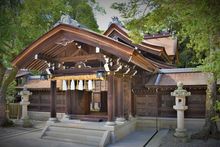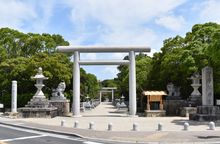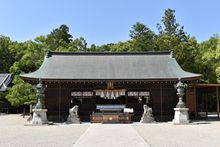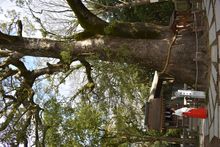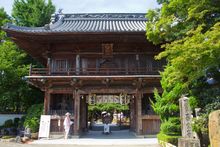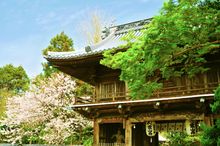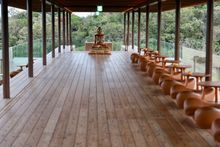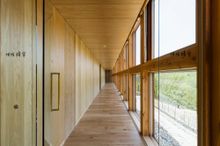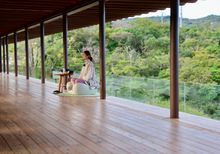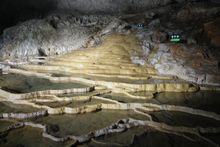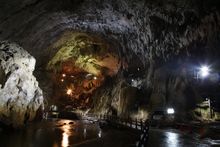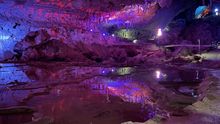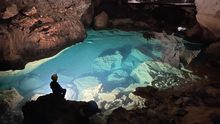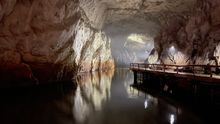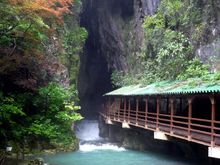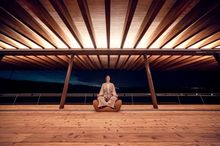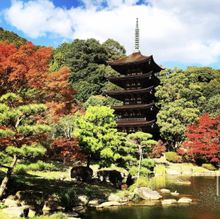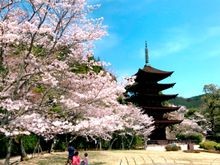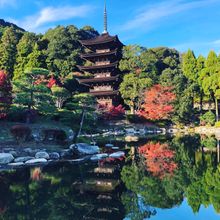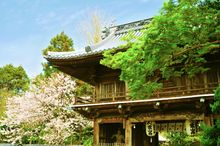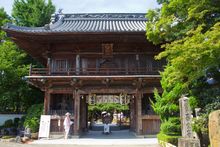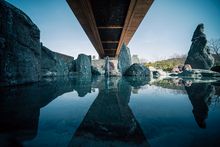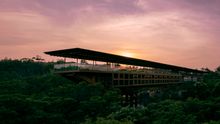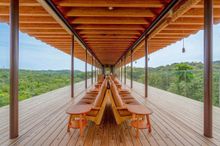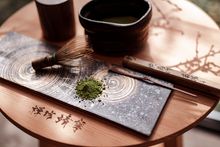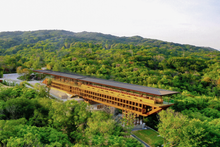 22 Feb 2025
22 Feb 2025
Tags: Japan, Setouchi, spiritual, Nature, Shinto, Awaji, Zenbo Seinei, izanagi jingu, Akiyoshido, Ryozen, Tokushima, Rurikoji

Japan's native belief system, Shinto, is centred around humans' relationship with the natural world. According to Monasteries.com a third of Brits are planning a spiritual escape in 2025 and the Setouchi region's wealth of natural landscapes, power spots, retreats and awe-inspiring shrines invite visitors to benefit from this abundance of natural and spiritual energy.
Find your zen on Awaji Island
Zenbo Seinei on Awaji Island is a profoundly peaceful retreat where visitors can distance themselves in nature and zen architecture. Designed by Shigeru Ban, a Pritzker Prize-winning architect, the striking minimalist structure rising from the forest features a 100m long cedar-wood deck and stands in harmony with the expansive seasonal landscapes. Guests can choose between a day/evening plan or two-day overnight journeys across themes including Clean Beauty and Mind-Body Function. All are designed to facilitate moments of stillness and reflection. Here the daily rhythm is deliberately unhurried and smartphone free with activities centring around zen meditation, yoga, calligraphy and mindful walking. Cuisine, under the supervision of a fermentation and brewing chef, is vegan, inspired by temple cuisine and crafted using local and seasonal ingredients, sourced from the island's land, waters and onsite seasoning brewery. Prices start from Yen 10,000 (£52) for a one hour sunset retreat. An overnight stay starts from Yen 48,000 (£250) plus 10% service charge.
Also located on the island, and a 30-minute drive from Zenbo Seinei, is Izanagi Jingu Shrine, the oldest shrine in Japan and a recognised power spot for bringing good fortune. It is rooted in the nation's creation mythology as it enshrines the gods Izanagi and Izanami who appear in the Kuniumi, a myth that describes the formation of the Japanese archipelago. The shrine is also at the centre of the Hinomichi Shinto alignment, a series of shrines aligned with the sun's path during the spring (20 March 2025) and autumn (23 September 2025) equinoxes.
Discover a mysterious underground world at Akiyoshido Cave
Akiyoshido Cave is one of the largest limestone caves in Japan sitting beneath the Akiyoshidai plateau and its formation began approximately 350 million years ago. Visitors can marvel at nature's artistry with natural sculptures and stalactites including The Golden Pillar as well as The Hundred Plates created by water cascading over the terraced rock formations. The caves can be explored as part of a pre-booked cave exploration tour that allows visitors to access hidden areas in the labyrinth. A picturesque stroll can be enjoyed along a turquoise riverway that leads out of the cave, and the vast karst landscape can be explored by bicycle, segway or tuk-tuk. Cap off the experience with a taste of local delicacy gobou-men - burdock-infused noodles topped with crispy fried burdock. Burdock is a native root that grows on the plateau and is a powerful antioxidant aiding digestion.
The caves are open from 8.30am to 5.30pm (March to November) and 8.30am-4.30pm (December to February). Segway tours are held twice a day at 9.50am and 3.40pm from mid July to late August, and at 12.50pm during other periods.
Embark on a pilgrimage from Ryozen-ji Temple
Ryozenji Temple, located in Naruto City in Tokushima Prefecture and established around 1,300 years ago, is the first temple on the renowned Shikoku pilgrimage. This 1,460km route traverses the 88 temples associated with Buddhist Monk Kukai (Kobo Daishi) across the stunning landscapes of Shikoku. As the starting point Ryozenji plays an important role not only as a place to experience history and reflect in the temple's main hall and pagoda, but also for those seeking spiritual purification and healing. It also serves a practical role for pilgrims embarking on the journey with places to purchase traditional pilgrim attire (hakui and sedge hats) along with necessary items like walking sticks and stamp books (nokyocho) that are used to collect seals at each temple. Pilgrims, known as henro, often speak of the journey as one of self-discovery. Open 7am to 5pm year round.
See the unveiling of the restored Rurikoji Five-Story Pagoda in 2026
Planning ahead for visits in April 2026 will see the Rurikoji Five-Story Pagoda unveiled after a multi-year renovation. Located in Yamaguchi, this Muromachi-period (1393-1466) masterpiece is often regarded as one of Japan's finest examples of traditional pagoda architecture and the temple is dedicated as the shrine of Yakushi Nyorai, the Medicine Buddha, drawing visitors to pray for their health. It's therefore a fitting location for the six-metre high Reiwa Great Buddha, a contemporary wooden statue that was completed in 2023 by artist Shinji Maeda and Buddist priest-artist Tenshin Kazama. The project brings together mini statues created in nationwide workshops during the COVID-19 pandemic.
These experiences are all part of Setouchi Journeys, a series of itineraries designed to encourage visitors to mindfully explore deeper into this destination that's rich in centuries-old culture, icons of Japanese cuisine and island idylls. To find out more visit www.setouchi.travel/en.
-ENDS-
About Setouchi DMO:
Setouchi DMO is comprised of the seven prefectures that make up the Setouchi Region surrounding the Seto Inland Sea and its islands - Hyogo, Okayama, Hiroshima, Yamaguchi, Tokushima, Kagawa, and Ehime. Setouchi Journeys was developed by Setouchi DMO to help make the region more accessible to visitors by dividing the area into four major zones. The Setouchi DMO is a travel brand formed by The Inland Sea, SETOUCHI Tourism Authority, which plans and carries out tourism marketing promotion, and the Setouchi Brand Corporation Inc. that supports tourism product development by utilizing the Setouchi Kanko Kasseika Fund. Their work to promote these destinations to domestic and international visitors aims to revitalise the local economy and create a prosperous regional society through the autonomous and lasting cyclical growth of the Setouchi area. https://setouchitourism.or.jp/en/
